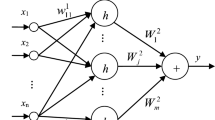Abstract
Current work introduces a fast converging neural network-based approach for solution of ordinary and partial differential equations. Proposed technique eliminates the need of time-consuming optimization procedure for training of neural network. Rather, it uses the extreme learning machine algorithm for calculating the neural network parameters so as to make it satisfy the differential equation and associated boundary conditions. Various ordinary and partial differential equations are treated using this technique, and accuracy and convergence aspects of the procedure are discussed.










Similar content being viewed by others
References
Moosazadeh S, Namazi E, Aghababaei H, Marto A, Mohamad H, Hajihassani M (2019) Prediction of building damage induced by tunnelling through an optimized artificial neural network. Eng Comput 35:579–591. https://doi.org/10.1007/s00366-018-0615-5
Koopialipoor M, Ghaleini EN, Haghighi M, Kanagarajan S, Maarefvand P, Mohamad ET (2019) Overbreak prediction and optimization in tunnel using neural network and bee colony techniques. Eng Comput 35:1191–1202. https://doi.org/10.1007/s00366-018-0658-7
Lagaris IE, Likas A, Fotiadis DI (1998) Artificial neural networks for solving ordinary and partial differential equations. IEEE Trans Neural Netw 9:987–1000
Lagaris IE, Likas A (2000) Neural-network methods for boundary value problems with irregular boundaries. IEEE Trans Neural Netw 11(05):1041–1049
Mai-Duy N, Tran-Cong T (2001) Numerical solution of differential equations using multiquadric radial basis function networks. Neural Netw 14:185–199
Aarts LP, Veer PVD (2001) Neural network method for solving partial differential equations. Neural Process Lett 14:261–271
Alli H, Ucar A, Demir Y (2003) The solutions of vibration control problems using artificial neural networks. J Frankl Inst 340:307–325
Malek A, Beidokhti RS (2006) Numerical solution for high order differential equations using a hybrid neural network-optimization method. Appl Math Comput 183:260–271
McFall KS, Mahan JR (2009) Artificial neural network method for solution of boundary value problems with exact satisfaction of arbitrary boundary conditions. IEEE Trans Neural Netw 20(8):1221–1233
Kumar M, Yadav N (2015) Numerical solution of Bratu’s problem using multilayer perceptron neural network method. Natl Acad Sci Lett 38(5):425–428
Mall S, Chakraverty S (2016) Application of legendre neural network for solving ordinary differential equations. Appl Soft Comput 43:347–356
Mall S, Chakraverty S (2017) Single layer Chebyshev neural network model for solving elliptic partial differential equations. Neural Process Lett 45(3):825–840
Kumar M, Yadav N (2011) Multilayer perceptrons and radial basis function neural network methods for the solution of differential equations: a survey. Comput Math Appl 62:3796–3811
Huang G, Zhu Q, Siew CK (2006) Extreme learning machine: theory and applications. Neurocomputing 70(1–3):489–501
Han F, Huang DS (2006) Improved extreme learning machine for function approximation by encoding a priori information. Neurocomputing 69:2369–2373
Rong HJ, Ong YS, Tan AH, Zhu Z (2008) A fast pruned-extreme learning machine for classification problem. Neurocomputing 72:359–366
Cybenko G (1989) Approximation by superpositions of a sigmoidal function. Math Control Signals Syst 2:303–314
Karlik B, Vehbi A (2011) Performance analysis of various activation functions in generalized MLP architectures of neural networks. Int J Artif Intell Expert Syst IJAE 1(4):111–122
Tawfiq LNM, Hussein AAT (2013) Design feed forward neural network to solve singular boundary value problems. ISRN Appl Math 2013:1–7
Sun H, Hou M, Yang Y, Zhang T, Weng F, Han F (2018) Solving partial differential equation based on Bernstein neural network and extreme learning machine algorithm. Neural Process Lett. https://doi.org/10.1007/s11063-018-9911-8
Huang GB, Zhu QY, Siew CK (2004) Extreme learning machine: a new learning scheme of FNNs. In: International joint conference on neural networks, July 25–29 2004, Budapest, Hungary, pp 985–990
Serre D (2002) Matrices: theory and application. Springer, New York, pp 147–147
Aziz I, Islam S, Asif M (2017) Haar wavelet collocation method for three-dimensional elliptic partial differential equations. Comput Math Appl 73:2023–2034
Acknowledgements
We express our sincere thanks to editor in chief, editor and reviewers for their valuable suggestions to revise this manuscript.
Author information
Authors and Affiliations
Corresponding author
Additional information
Publisher's Note
Springer Nature remains neutral with regard to jurisdictional claims in published maps and institutional affiliations.
Rights and permissions
About this article
Cite this article
Panghal, S., Kumar, M. Optimization free neural network approach for solving ordinary and partial differential equations. Engineering with Computers 37, 2989–3002 (2021). https://doi.org/10.1007/s00366-020-00985-1
Received:
Accepted:
Published:
Issue Date:
DOI: https://doi.org/10.1007/s00366-020-00985-1




